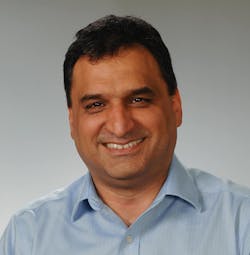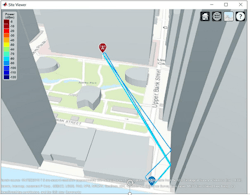Leveraging Space for Next-Gen Communications Networks
What you’ll learn:
- RF as an infrastructure aspect of society.
- The growth of space-based communications.
- Software and simulation design trends.
Our ever-growing IoT-focused, cloud-enabled society is challenging the electronics community to provide the needed infrastructure to support all the promised and desired user-oriented functionality. Beyond growing-out terrestrial systems, we also must leverage space operations more than we have done to date, presenting additional challenges to development.
We recently sat down with Houman Zarrinkoub, Senior Wireless Product Manager at MathWorks, to talk about the intersection of wireless trends and satellite communications. Also discussed is how engineers in this space can integrate simulated testing into workflows to ensure robust prototypes before deploying.
Hi Houman, welcome to the show. Now wireless is an integral infrastructure aspect of modern society, to the point where if it stopped working, humanity would collapse within like six minutes. Once upon a time, wireless tech was all broadcast. Where did you think the tipping point occurred? Where would you draw the line in the history books, where RF became an infrastructure aspect of our society and not just a useful tool?
I would draw the line on the day that I went to undergrad. During those times in the 1980s, the internet became accessible to everybody with email. See, RF plus internet is the revolution of our times, because we used to communicate with other individuals through documents and mail. We would just put a stamp on the mail and send the messages back and forth.
So, the internet changed that to electronic domain, and the minute you have electronic communication, you can use all means possible: wireline, wireless, and so on. That took it from broadcast mode, which is essentially managed, monitored communication, to everybody communicating with everybody else. That is, to me, the tipping point, where the internet joined with wireless.
Now it’s space, as in outer space, that also has exploded in the aspect of wireless communications, both optical and RF.
Essentially, space belonged to our governments for a long time because it’s a very highly leveraged space. If you own the space, you can change everybody's lives. So, governments controlled the exploration, the Mars mission, the moon missions, and so on and so forth. But what I see as the trend that's happening, is that commercial interest in space exploration was proposed and accepted by all the governments in the world. That was something that opened up space in my view.
One could make the argument that it's always going to be about first exploration and then about commercialization.
That's it. Now to connect the two, I think the emerging trend of satellites for wireless communication has a much more practical motivation than exploration. The practicality lies in something that I want to tell you about. The objective of wireless communication lately, in the last 20 years, has been what's called ubiquitous connectivity. No matter where you are, you have access to reliable internet. Correct?
Now, two technologies have been spearheading that, and they are hitting their limits. First, we got internet connectivity through fiber optics and wireline. That was good, but wireline is expensive, much beyond wireless. Then came cellular. But with cellular, you have to buy the spectrum and put these base stations in the most economically advantageous areas, including useful places, urban places, suburban places, and around the highways.
So, there are a lot of holes on the ground, and that's where satellite communication comes in. If you find an economic way, as well as a technologically feasible way, to put satellites in the orbits for the purpose of wireless communication, with the same kind of expectation we get from ground systems, that's a big caveat. But, if you can make satellite communications less expensive, you solve the ubiquitous connectivity problem. That is the ultimate reason.
Now the better your core technologies get, the better the core technologies of what you're testing get. And the application spaces get faster, and broader, and deeper. And your equipment has to be that much faster, and that much broader, and that much deeper than the solutions you're testing, or else you can't test them effectively.
It's true. And testing comes with a lot of challenges in terms of how many resources you are using and your design for space exploration. In the history of wireless communication, the radio stations and the cellular base stations were stationary, and all the users could move around with some speed.
To make satellite communication part of this wireless ubiquitous connectivity, you have to rely on a moving satellite. The days of geostationary satellites put on the equator are over because satellites have to be close to you, not above the cloud. It has to be around 500 km, 1,000 km, max.
Now, if you do that, you have to zoom around in a lower orbit. Meaning, mobility and managing mobility, and the effect on quality, is a major issue. And, then, one of the most important things in the history of wireless is multiple access and providing service to multiple users at the same time. This is a huge topic. CDMA and TDMA is all about multiple access.
Now, in satellite communication, there is another challenge: If your LEO satellite serves you for only two minutes, then you have to connect to another service provider that comes on the horizon two minutes later, and another one, and another one after that. So, you're talking about simultaneously getting service from multiple different satellites, and the scale of the multiple-access problem is huge. Various dimensions of complexity grow quickly, and in the first iteration. You cannot solve it later. You have to solve it in the first round.
Then the most important problem is the liability. You have to make sure that they maintain their orbit. If you have to change the orbit, you coordinate with everybody else. Imagine the command and control aspects of that. You have to have control over that physical device at all times.
Robustness, mobility, precision, and accuracy are all things that if you don't solve first, you are not allowed to put into orbit. That's the entry point to our solution—everything has to be fully qualified in software, in simulation, before even one asset goes up in the air. Otherwise, nobody will accept your proposal for certification.
Well, then, walk us through how you help the engineers ensure the integrity of their simulated tests, and ensure that what they're fielding will meet expectations, even with the dilemma of the modern engineer working with multiple disciplines.
Exactly. Despite the fact you may not be an expert, you have to understand enough to address that interaction with all of the other elements in your system to design the whole thing. This is where MathWorks comes in. We provide that multi-domain. The platform of MATLAB, which is a platform that everybody, every engineer, uses and loves, is the area where all those qualifications, all those interactions can be tested. You can have easy and interactive 5G waveform generation with the Wireless Waveform Generator App (Fig. 1).
This is the value proposition. If you're designing a multi-domain, multi-disciplinary system, MATLAB combines the design element and this design exploration in that one environment, and really takes you to the next level of addressing those challenges, because in person-to-person communication, those silos and gaps and walls, go away. The RF engineer puts the RF spec in there, which gets picked up by the modem guy, and he adds the modem stuff in there. Then the scheduling guy adds the MAC stuff in there. In one environment, you can actually verify the interaction between all these essential components.
That leads to another question. There are a lot of trends in our currently disruptive environment, and another of these trends is collaborative software. COVID presented the collaborative software community with a perfect storm. It had to develop and grow. Now collaborative software is another major force in the industry that we can no longer back away from.
This is the case for the challenges of satellite communication or wireless connectivity; the collaborative software has a goal. It's called collaborative design. If you want to collaboratively design all these different disparate components of a complex satellite communication system, you have to have people with different expertise communicate in the same platform. That's the same value that collaborative software gives you.
If you put your expertise in there, everybody else can see the impact of that in the same platform, in the same environment. That's how I see it, a specialization of collaborative software for the purpose of designing any kind of system.
That's very empowering.
One of the major things that happened with 5G is the introduction of millimeter wave, which enables beamsteering and such. Now, believe it or not, the industry did that without a single millimeter-wave chip being available on the market. People really started buying the spectrum. People started buying up the spectrum for those frequencies. But then if you wanted to actually test whether this thing would work, there was no chip available.
Many companies, including our customers, put a model of that chip in software. Every component of that chip was modeled in software mathematically. Then, they connected that with a signal that would go to a chip, and it put all the tests in there before the chip was made. Even before the chip was made, the specifications of what the chip should do was already specified by the software. Then the chip was made.
Instead of building the prototype first and then modeling it, you model it and then build a prototype based on that. This is something that got the company that used our tools to model that; the first millimeter-wave contract by the big cellular suppliers, for the small companies, small startup companies. So, if you do it in software first, and the software reflects reality enough, then you can qualify even before the first prototypes are made (Fig. 2).
It's a sign of the times, isn't it?
The days of silo working are over. You have to combine things and you have to combine things to the environment that it's going to be the final environment of implementation. You cannot just say, "Trust me, it will work." You have to show in software that if you put it in that environment, it's going to work on day one.
Those would be good closing words, but do you have any final thoughts for our audience?
The final thought is that what we are doing is in line with where the engineering discipline is going, essentially modeling reality at such a high fidelity, that your design is guaranteed to work when you go to implementation. This is where the engineering discipline is going. You know enough about the physical reality and all its manifestations and all these parameters and complexities, that you can create a tested robust system for your purposes on day one.
The role of simulation is not a requirement now. It's not a nice feature to have anymore. If your simulation design is required to be robust and accurate from day one, having a platform of simulation, which handles all those different environments of design—in this case, wireless communication, antennae, modem, and all that—will get you there faster, and that's why we're in business. That's what our excitement and passion is. That's why.




